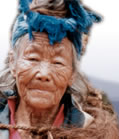Every attempt has been made to gloss all the terms in the testimonies, but finding the meaning for all of them has not proved possible. Some may have been misheard or mistranscribed; some are locally and culturally specific, especially those from the southwest.
| administrative village |
Under the government’s
administration structure, one “administrative”
village comprises several “natural” villages,
usually less than ten (see township). |
| animal year |
reference to the Chinese system
of certain years being identified with particular animals
and their characteristics |
| Anxihui |
Seventh Day Adventists; a Christian
movement |
|
baima |
person who deals with the spirit
world. Such people play a prestigious role in the belief systems
of the different minority peoples, but “outsiders”
often connect them negatively with superstition and wrongdoing. |
|
baocan |
Literally “responsibility
for produce”; under the household responsibility system,
the total yield of one family is the produce of every member
within the family. |
| barefoot doctor |
medical practitioner providing
a free service at village level. Local people were given a
basic training in primary health care, using traditional and
Western medicine. Introduced under Chairman Mao, the policy
reached its peak in the early 1970s when over 2 million barefoot
doctors were trained; since the introduction of a user-pay
policy in the 1990s the system has disintegrated. |
|
beizi |
landscape of fertile plains surrounded
by mountain ranges, typical of Yunnan province. |
| Big Spring |
late January/early February,
depending on the lunar calendar |
|
cadre |
refers to a public official holding
a responsible or managerial position, usually full time, in
party and government. A cadre may or may not be a
member of the CCP, although a person in a sensitive position
would almost certainly be a party member. |
|
chaste tree |
a deciduous tree with flexible
branches and twigs, which are often used for basket-making |
| cogon grass |
a tough grass, used for thatching
|
| commune system/
collectivisation
|
introduced by the Communist party
in the 1950s. The country was divided into settlement areas
(communes). People worked collectively, all produce was pooled
and shared out according to the number of heads in a household
as well as work points earned. Replaced by the household responsibility
system in 1978. |
| corn rice |
corn rice is a mixture of the
two and cheaper than pure rice; most farmers’ land in
these mountains is only suitable for growing corn |
|
congee |
thick rice soup made with plenty
of water or broth to which a variety of flavours and foods
can be added. Nutritious and easily digested, it is especially
good for babies, old people and invalids. This porridge-like
staple was not just “peasant food” but was enjoyed
by all classes. |
| Cultural Revolution |
nationwide movement from mid-1960s
to mid-1970s, under Mao’s chairmanship. The aim was
to destroy the “four olds” – old ideas,
customs, cultures and habits – and “build the
new China”. It was a period of widespread political
purges, in which Mao’s Red Guards (the youth movement
charged with affecting the revolution) targeted “reactionary
intellectuals”. Rival factions fought each other, there
was widespread suffering and much of China’s cultural
and intellectual heritage was destroyed. |
|
dajinjiao |
a branch of Christianity which
spread to China in the 6th and 7th centuries from Persia,
and originated with Pope Nestorius in Rome in 5 AD. Jin
jiao had been used as a general name for Christianity
in China since before 1949. Dajinjiao literally means
big jin jiao (ie big Christianity); xiaojinjiao
means small Christianity, presumably different variations |
| Dragon Boat Festival |
Fifth day of fifth lunar month;
the celebration is a time for protection from evil and disease
for the rest of the year. |
|
dystocia |
abnormally difficult and painful
childbirth, including breech births. |
|
fen |
the smallest unit of currency
(10 fen = 1 jiao; 10 jiao = 1 yuan);
also a land measurement (10 fen equals 1 mu) |
| Guomindang |
when the Nationalist Party (Guomindang)
was fighting the Communist Party – 1940s or early 1950s.
See also “liberation” |
| gunny/ gunny blanket/ gunny cloth
|
made from flax or hemp –
blanket, cloth or clothing (also called sackcloth) |
| household responsibility system |
introduced in 1978 by Deng Xiaoping.
Every household is allocated its own piece of land and is
free to work it as it chooses, keeping most of the harvest
but handing over a certain amount as “tax” to
the government. |
|
huanquin |
a form of arranged marriage,
in which two families effectively exchange sons and daughters,
hence known as “exchange marriage”. The son of
family A marries the daughter of family B; the son of family
B marries the daughter of family A. Huanqin remains
a tradition in some rural parts of China. |
| interval |
In 1991, the policy of one child
per family (instituted in the 1980s) was amended. Couples
in certain minority groups are now allowed two children providing
the second is born after an interval of five years (or, in
some cases, four – administrative areas are permitted
some discretion). If the interval is less, the family can
be fined. (See also quota.) |
|
jiaohun |
literally “calling the
spirit”; traditional Lahu practice through which ancestors’
spirits who are troubling their surviving relatives (causing
illness, for example) are persuaded to leave their families
in peace. |
|
jiao |
unit of currency: 10 cents equals
1 jiao ;10 jiao equals 1 yuan |
|
jin |
a weight measure (of corn, meat
etc); 2 jin equals 1 kg |
|
kang |
a sleeping platform made from
bricks or adobe, with pipes inside to carry heat from the
stove to the chimney. A source of heat in winter, it is typically
found in northern Chinese villages |
|
koutou |
kow-tow, to bow down
and pray. Kou means knock and tou means
head, hence kow-tow meant to touch/knock the ground
with one’s forehead while kneeling to express worship
(religious), or obedience/ submission to someone of higher
social status |
|
li |
measurement of distance; 1 li
equals 0.5 km; 2 li equals 1 km |
|
liang |
a measure (of rice, meat etc);
1 liang equals 50 grams |
|
leixiang |
literally, the sound of thunder.
A plot of land called leixiang means it depends on rain for
water, ie is not irrigated. |
| liberation army /
liberated / liberation
|
certain areas were “liberated”
from the control of the Nationalist party (the Guomingdang)
by the army under the leadership of the Chinese Communist
party. The People’s Republic of China was established
in 1949, when most of China was under Communist control; “liberation”
could have taken place any time from the late 1940s to the
early 1950s. |
“made by the state” |
term used by villagers to mean mass-produced
goods, not hand-made, because formerly all factories were
owned by the state |
mahjong |
popular Chinese board game |
metritis |
inflammation of the uterus |
“middle man” |
Someone involved in the practice of trading
in wives, which is now considered a crime |
middle school |
usually for ages 12-15 |
mu |
area of land: 1 mu equals 0.067 hectares;
15 mu equals 1 hectare |
nationality |
meaning different “ethnic groups”
within China, including the Han, rather than “nationality”
in the nation state sense (as in “Chinese”). “Nationality”
is commonly used in this way in China, and has its origins
in Stalin’s definition of nations/nationalities, on
which the Chinese Communist Party officially based its definitions
of ethnic groups within China in the 1950s and 1960s. |
National Minority Affairs Committee |
government body, responsible for the welfare
of minority peoples and for policymaking and implementation.
China has 55 minority ethnic groups, comprising around 8%
of its total population. The committee is also involved in
promoting minorities in government structures, and so assists
with job applications, for example. |
Neidihui |
China Inland Mission; a large Christian mission
established before 1949. |
nutrient bag |
small bag filled with nutrients and rich soil
to nurture seedlings. Once the seed has germinated, the bag
is cut open and the seedlings are planted out in fields. |
quota [in family planning] |
China’s family planning policy is more
flexible in rural areas, and for minority peoples. In 1991,
the policy of one child per family was amended, and certain
minority groups are now allowed two children providing the
second is born after an agreed interval (see interval) |
radical mu |
every Chinese character in the written language
is composed of one radical and several strokes. Sometimes
a radical standing by itself can be a character and carry
a meaning on its own |
sackcloth |
made from flax or hemp – blanket, cloth
or clothing. Also called gunny cloth. |
sheng |
unit of capacity: 1 sheng equals
1 litre |
Small New Year |
The big New Year is the lunar new year, the
first day of the lunar calendar; the small New Year is the
15th day of the first month of the calendar |
Small Spring |
late February or early March, depending on
the lunar calendar |
spirit dance /
spirit thread
|
possibly connected with Lahu practice of “calling
the spirit”: see jiaohun |
Spring Festival |
major national festival every January or February,
depending on the lunar calendar |
state [produced by] |
term used by villagers to mean mass-produced
goods, not hand-made, because formerly all factories were
owned by the state |
substitute teacher |
someone not yet qualified and filling a position
in areas where the government can’t recruit enough qualified
teachers. The salary is lower and the position much less secure
than that of qualified staff. |
team |
cluster or group, made up of several households
within a village or community; a unit under the government’s
administrative structure (see township). |
tiger shoes |
found on babies’ feet throughout rural
China. Handmade of cloth, with toe caps made into a tiger’s
head, they are believed to protect children from harm. |
township |
administrative units in China are, in descending
order of size: state; province; district/ prefecture; county/city;
township; administrative village; natural village; cluster/team;
household |
trader in wives |
See “middle man” |
women’s officer |
one woman in every administrative village
is appointed as the women’s officer, responsible for
coordinating all the government’s assigned tasks among
women; she may or not be paid a small allowance |
work points /
work score
|
the work-point system was implemented from
the late 1950s to late 1970s as part of collectivisation.
All farmers in the same unit shared responsibility for production.
Produce was pooled and shared out according to each farmer’s
work score. The more hours worked, the higher the number of
work points earned. Men earned more points than women and
women’s reproductive work was discounted |
wubaohu |
Literally “five-guarantee”; a
category of household under the welfare system for the elderly
provided by the government’s Civil Affairs Department.
The household is guaranteed special assistance in five areas:
food, clothing, housing, medical care and burial services.
Eligible households are the elderly living without children. |
xiaojinjiao |
jin jiao had been used as a name
for Christianity in China since before 1949; xiaojinjiao
means small jin jiao (small Christianity). See also
dajinjiao. |
yuan |
unit of currency; 10 jiao equals
1 yuan |


